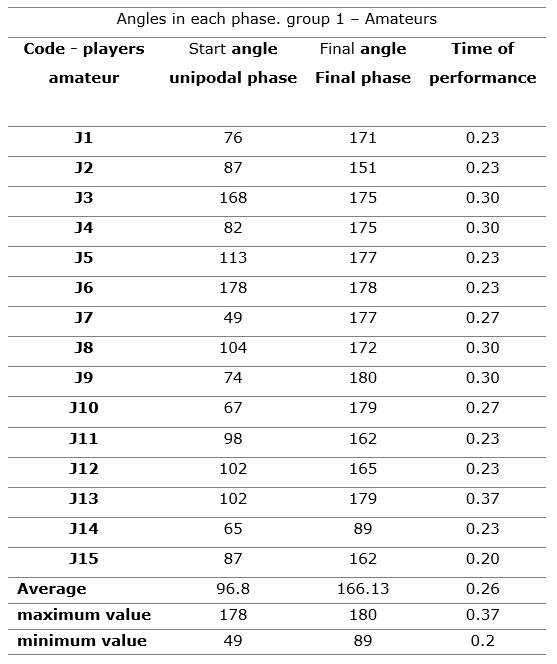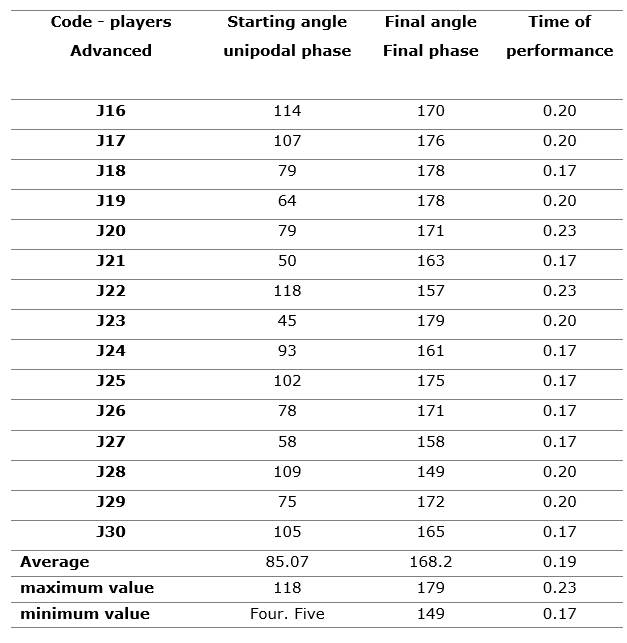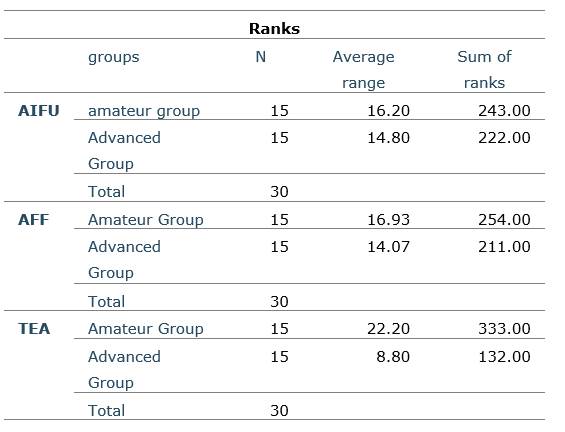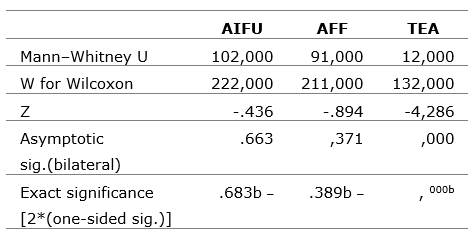Mi SciELO
Servicios Personalizados
Revista
Articulo
Indicadores
-
 Citado por SciELO
Citado por SciELO
Links relacionados
-
 Similares en
SciELO
Similares en
SciELO
Compartir
Podium. Revista de Ciencia y Tecnología en la Cultura Física
versión On-line ISSN 1996-2452
Rev Podium vol.17 no.2 Pinar del Río mayo.-ago. 2022 Epub 20-Ago-2022
Original article
Biomechanical differences between advanced and amateur players in the execution of the free kick in soccer
1Universidad de las Fuerzas Armadas-ESPE. Quito, Ecuador.
The free kick in soccer is one of the important sports techniques, which allows the game to resume after a foul committed by the other player. The enhancement of specific motor skills allows the development of higher performance in the short and long term, for which its characterization is important to develop specialized methodologies in the stages of sports initiation. In this sense, the present research aimed to analyze the biomechanical differences of the free kick between advanced and amateur soccer players. This study is of a descriptive-explanatory type of correlational order, 30 soccer players from the Chiqui Park Soccer School (16-32 years of age) are intentionally diagnosed, classified into two independent groups, group 1 with advanced soccer players, and group 2 with amateur level soccerers. Three variables of interest are evaluated: the Initial Angle of the Unipodal Phase (AIFU in Spanish), the Final Angle of the Final Phase (AFF in Spanish), and the Execution Time of the Free Throw (TE in Spanish). There are no significant differences between independent groups in the angular variables AIFU (p=0.683) and AFF (p=0.389), and a significant difference in favor of group 2 in the variable TE (p=0.000). However, all the average ranges favored the advanced level players. There is a need to comprehensively establish larger studies that characterize the training categories studied, serving as a theoretical basis and methodology that supports the development of technical-tactical and physical actions of consideration in the processes of sports training management.
Keywords: Biomechanics; Soccer; Execution time; Articular angles.
INTRODUCTION
The study of sports technique is one of the fundamental elements of the sports training management process in any modality (León et al., 2016) including soccer (Vizcaíno, Cortizo, 2020; Carbo et al., 2019). Various sports science professionals frequently use the specialty that studies mechanical interactions to describe motor movement; from here, advantages and limitations are detected to make decisions that improve physical skills of the sport, as would be the case of the spike in soccer, (da Silva Junior et al., 2019) . In this work, the fundamentals of all movements and mechanical variations are analyzed, improving the technical gesture, and therefore, improving sports performance.
Sports biomechanics by focusing on the study of the mechanics of the locomotor system of athletes, analyzes the body structure, which objective is to enhance the correct execution of the technical gesture. In this sense, various biomechanical studies have been applied to improve key indicators of motor movement in soccer players; such is the case of the auction with the head and the lower limbs, (Filben et al., 2021; Zhang et al., 2020). For this purpose, corrective measures are taken if necessary, such as the implementation of corrective exercises with elastic bands to achieve greater precision in the kick (Abdel Aziz Habib, 2018).
The free kick in soccer is one of the ways to start the game after committing a technical foul by the opponent (Ardá, Casal, 2018). This element is even analyzed from the motor point of view, as is the case in the work of Espinoza et al., (2021) and Sánchez et al., (2018). The improvement of the free kick in soccer includes the analysis of the focus of attention during technical-tactical learning, (Schwab et al., 2019), the kinematics of free kicks themselves, (Aziz, Bylbyl, 2019) and the enhancement of its effectiveness from physical stimuli with a variety of exercises, as described by Mohammad, (2021).
Sports biomechanics and soccer are interrelated to define the characteristics of the skills and improve the functioning of the mechanical effectiveness of the different skills that this sport encompasses. From this edge, the factors that contribute to performance in athletes are identified; which objective leads to obtain specific learning for optimization when executing a sports action. The phases of the execution of the technical gesture of the free throw are; starting position, impulse run, single leg position, contact with the ball and position of the ball.
In the present research, two phases of the technical gesture will be prioritized, which includes the unipodal position described in Briceño, Gómez, (2011). These positions are described below: the supporting lower limb must be flexed at the knee with the foot close to the ball, and with the sole of the foot fully supported on the surface of the ground, the pendulum lower limb , which must remain flexed at the level of the knee joint. This extends at the level of the corresponding hip, to execute the countermovement action that will trigger the free throw collection phase; the upper limbs must remain semi-flexed at the level of the elbows.
Another indicator of importance is the final position of the technical gesture of the free throw, in which it will be called the final position. This is described when the ball is already projected, the athlete must adopt an ideal position to subsequently carry out an action, whether defensive or offensive (Briceño, Gómez, 2011). The study of movement patterns requires the analysis of various indicators, which will serve directly and indirectly in the teaching-learning process. In this sense, the present research aims to analyze the biomechanical differences of the free kick between advanced and amateur soccer players.
MATERIALS AND METHODS
The research is of descriptive-explanatory type of correlational order; an intentional sample of 30 players from the Chiqui Park Soccer School (16-32 years old), in Quito, Ecuador, is diagnosed. Players are classified into two independent groups, they are: group 1 of amateur players, and group 2 of advanced players. Players in the advanced category have considerable sports longevity, they are athletes from the age of 12, while amateur players only have two years of scientific training.
Among the inclusion criteria of the studied sample, it was delimited that the player belongs to the school and the category mentioned; they must not have lesions that limit the recording and processing of the information of interest, and must have the informed consent signature. The free kick will be taken in front of a goalkeeper of the same category or level, respecting the protocols or rules of soccer.
For this research, the following variables or analysis indicators are studied:
Initial Angle of the Unipodal Phase (AIFU): the player keeps one foot in support while the other foot remains behind the torso; thus gain more momentum and strength on the ball. At the hip joint of the supporting leg, the most active muscle is the gluteus maximus muscle, on which point most of the weight will rest. The supporting leg is kept fully extended in which the quadriceps and the rectus muscles work with the hip flexed. This helps to stabilize the leg, while the leg that is going to make contact with the ball should meet with a slight bend in the knee where the initial angle to be analyzed occurs.
Final Angle Final Phase (AFF): From this position, now, the leg with which the movement is executed performs an extension of the knee mainly, together with the hip, performed by the quadriceps in all its parts (vastus medialis, lateralis, rectus femoris and cruris). The concentric contraction of the iliopsoas allows the attraction of the entire member from the backward position, until now an advanced one where the final angle to be analyzed is produced.
Execution time (TE): Once the player's speed is constant, the execution time from the initial angle of the unipodal phase (AIFU) is taken into account. In this, there is one support leg on the ground and another with a slight knee flexion, passing through the contact of the ball until reaching the final angle of the final phase (AFF). In this, a knee extension is produced and that is when the execution time to be analyzed ends.
Kinovea program was used to carry out the measurements, in terms of initial and final angles and execution time of the players in the execution of the free throw. On the other hand, the tabulation of the data was carried out, using Microsoft Excel 2021, and SPSS v25 was used for correlational statistical processing, specifically to determine the existence or not of normality through the Shapiro-Wilk Test, as well as the comparison of the data of interest through the non-parametric Mann-Whitney U statistic (pd"0.05) for two independent samples.
RESULTS
Table 1 shows the results recorded in the free throw technique in the different indicators for each phase of the movement, for group 1 or amateurs; in the last three rows, the average or arithmetic mean, the maximum and the minimum value, respectively, are shown (Table 1).
As shown in table 1, the average value obtained in the Initial Angle indicator of the Unipodal Phase was established at 96.8°, with a maximum value of 178° and a minimum value of 49°. On the other hand, the mean or average established in the Final Angle of the Final Phase was 166.13°, with a maximum value of 180° and a minimum of 89°, while the results in the Execution Time indicator were established in 0.26ms, with a maximum value of 0.37ms and a minimum of 0.2ms.
On the other hand, table 2 shows the results recorded in group 2 or advanced players (Table 2).
As shown in Table 2, the average for the group of advanced soccer players in the AIFU indicator was 85.07°, with a maximum value of 118° and a minimum of 45°. On the other hand, in the AFF indicator, an average of 168.2° was established, with a maximum value of 179° and a minimum of 149°; while in the TE indicator the mean was established at 0.19ms, with a maximum value of 0.23ms and a minimum of 0.17ms.
In the comparative calculations, the Mann-Whitney U Test was used for two independent samples; the variables or indicators of interest are compared (Table 3) and (Table 4).
As evidenced in table 3, there were no significant differences in the AIFU variable (p=0.683), although group 2 of advanced soccer players showed a lower average range (14.80) than the group of amateur soccer players (16.20); hence an initial angle in the unipodal phase of lesser degree is obtained.
AFF variable, the Mann-Whitney U Test did not present significant differences (p=0.389); although the group of advanced soccer players also presented a lower average rank (14.07) than that obtained by group 1 (16.93). From this edge a smaller final angle of the Final Phase is obtained when executing the free kick.
TE variable or indicator, there were significant differences (p=0.000) in favor of the group of advanced soccer players. This is due to the lower average range obtained by group 2 (8.80) compared to group 1 (22.20) in the execution time of the free throw technique. The result is indicative of greater strength and speed in terms of physical abilities in favor of players with greater sports longevity or advanced level.
DISCUSSION
As has been determined in the methods section, advanced players have several years of training and technical perfection; this becomes a better reference to establish performance parameters that serve as a comparative base, as defined in Morales (2014) and (2019). In this sense, athletes with more experience should obtain better performance indicators, who achieve better results in determining capacities such as speed and strength. In the present study, an average execution time of the free throw technique of 0.19 thousandths of a second was found in favor of group 2, which is higher than the 0.26 thousandths of a second in the execution time execution of an amateur player.
The starting angles of the amateur players obtained an average of 96.8º, and that of the advanced players was 85.07º. These results reflect that the starting position of amateur players is more fluctuating; which constitutes in some cases greater the angle in which they start the free throw kick, since they do not yet have a perfected technique. Variations in sports technique are due to numerous variables, normally related to the age ranges of athletes. In this sense, (Conesa, 2019) specifies the need to establish the scales required for establishing the evaluation regulations in young soccer players. These are which govern training actions in the short and medium term, at least from the point of view of speed and explosive strength; although in the opinion of the authors of this research, technical aspects must also be included, where biomechanics has its vital space (Sánchez, 2018; Espinoza et al., 2021).
In the final angle, it is observed that the amateur players have an average of 166.13º, and the average angle of the advanced players is 168.20º. This is due to the fact that the players of the amateur category at the time of making the free throw and once the ball is off the ground, allow the strength to continue stretching the foot. This depends on the technical deficiencies, which makes them stretch more the leg that hits the ball. On the other hand, advanced players, having more training experience in taking the free kick, already know that they need to return the leg that hit the ball, due to the possibility of another technical-tactical move immediately.
Unlikely, the advanced level soccer player demonstrates a more efficient technical execution, with emphasis on the development of the technical component. This is due to the fact that the speed of implementation at the moment of connecting the foot to the ball allows a greater generation of power in the shot with respect to the execution of an amateur player. It follows from this that there is no such speed and strength in the latter; however, it does not detract from making a free kick with a higher degree of precision, but without greater power.
Physical preparation is also important to be able to execute a free kick effectively (Abdel-Aziz Habib, 2018; Carbo et al., 2019); not only the technical part affects the good execution. However, strength, speed, and power then affect overall performance, whether the free kick is for long, medium or short distances (Yepez, Ramirez, 2019).
The player's environment greatly affects the implementation of the technical factor, due to the training that each foot player receives in each training session. Advanced players put more emphasis on training due to the improvement they perceive in the tactical and technical fields, in order to have a life of higher performance around soccer. On the other hand, there is uncertainty in the amateur players, since they do not see the improvements in the short term, because the training sessions are less frequent in the case of the Ecuadorian environment; thus, the principle of systematicity of the physical load is affected, given that many amateur level soccer players have other activities of greater relevance in their daily lives, and less long-term interest in developing their life around soccer.
CONCLUSIONS
In the present research, there are no significant differences in the initial angle of the unipodal phase, and in the final angle of the final phase of hitting the ball in the free kick action in soccer. However, certain differences are evident in the average ranges in favor of the group of advanced soccer players, which indicate the need to comprehensively establish larger studies that characterize the training categories studied. This serves as a theoretical basis and methodology that supports the development of technical-tactical and physical actions of consideration in the management processes of sports training.
From the point of physical capacity, the execution time of the free throw technique shows significant differences in favor of the group with greater sports longevity (Group 2). The existence of greater strength and speed in advanced soccer players is deduced, a logical aspect when presenting a greater age range and sports experience than that presented in amateur level soccer players.
ACKNOWLEDGMENT
To the "Chiqui Park" soccer training school for the opening and availability provided at the time of data collection. To the AFIDESA Research Group (Physical Activity, Sports and Health) of the University of the Armed Forces ESPE, and to the Naval Force for advice and implementation of the intervention proposal.
REFERENCIAS BIBLIOGRÁFICAS
Aziz, D., & Bylbyl, S. (2019). The free kick kinematics of elite football players. Education, 4(2), 18-27. https://doi.org/10.11648/j.ijsspe.20190402.11 [ Links ]
Briceño, G., & Gómez, M. (2011). Estudio biomecánico de la fase activa del cobro de tiro libre golpeando el balón con el borde interno del pie en el fútbol de campo. Lecturas: Educación Física y Deportes, 16(161), 1-4. 10/10/2021. https://www.efdeportes.com/efd161/estudio-biomecanico-del-tiro-libre-en-el-futbol.htm [ Links ]
Carbo, G. B., Vélez, W. R., Cañizares, R. A., & Echeverría, C. A. (2019). Perfeccionamiento en la técnica de conducción, golpeo y recepción en futbolistas de iniciación. Lecturas: Educación Física y Deportes , 24(251), 42-61. 18/09/2021, 18/09/2021, https://www.efdeportes.com/efdeportes/index.php/EFDeportes/article/view/1243/684 [ Links ]
da Silva Junior, J. E., Ciccarelli, O. A., Pita, I. M., & de Carvalho, C. L. (2019). A importância da análise biomecânica do chute no futebol. Um estudo de caso. Lecturas: Educación Física y Deportes , 24(251), 81-92. 19 /09/2021. https://www.efdeportes.com/efdeportes/index.php/EFDeportes/article/view/568/649 [ Links ]
Espinoza, O. D., Morillo, M. A., & Apolo, E. (2021). Diferencias biomecánicas del tiro libre en el fútbol entre jugadores del club Jit y Atahualpa. Ciencia Latina Revista Científica Multidisciplinar, 5(4), 4520-4538. https://doi.org/10.37811/cl_rcm.v5i4.635 [ Links ]
Filben, T. M., Pritchard, N. S., Miller, L. E., Miles, C. M., Urban, J. E., & Stitzel, J. D. (2021). Header biomechanics in youth and collegiate female soccer. Journal of biomechanics, 128(9), 110-782. https://doi.org/10.1016/j.jbiomech.2021.110782 [ Links ]
León, S., Morales, S., & Chávez, E. (2016). Morfología funcional y biomecánica deportiva (2 ed.). Quito, Ecuador: Editorial de la Universidad de las Fuerzas Armadas ESPE. https://www.researchgate.net/profile/Santiago-Calero-Morales/publication/319701166_Morfologia_funcional_y_biomecanica_deportiva/links/59bbd9df458515e9cfc795ec/Morfologia-funcional-y-biomecanica-deportiva.pdf [ Links ]
Mohammad, A. L. (2021). Effect of a variety exercises on some physical abilities and shooting accuracy of free kick for. Turkish Journal of Computer and Mathematics Education (TURCOMAT), 12(13), 846-855. 15/11/2021. https://turcomat.org/index.php/turkbilmat/article/view/8539 [ Links ]
Morales., S. (2014). Optimización del proceso de dirección del entrenamiento en deportes de cooperación-oposición. Universidad de Guayaquil, Facultad de Educación Física, Deportes y Recreación (FEDER). Guayaquil: Eduquil. [ Links ]
Sánchez, J. W., Aguilar, J. A., Alava, D. J., & Cruz, M. G. (2018). Estudio biomecánico del tiro penal: comparación en futbolistas juveniles y de iniciación. Revista Cubana de Investigaciones Biomédicas, 37(4), 1-8. 12/10/2021. http://www.revibiomedica.sld.cu/index.php/ibi/article/view/205/html [ Links ]
Schwab, S., Rein, R., & Memmert, D. (2019). "Kick it like Ronaldo": a cross-sectional study of focus of attention effects during learning of a soccer knuckle ball free kick technique. German Journal of Exercise and Sport Research, 49(1), 91-96. https://doi.org/10.1007/s12662-018-0558-4 [ Links ]
Vizcaíno, S. F., & Cortizo, L. H. (2020). Caídas laterales bajas del portero de fútbol. Incidencia, biomecánica y entrenamiento. Lecturas: Educación Física y Deportes , 24(261), 3. https://doi.org/10.46642/efd.v24i261.1464 [ Links ]
Yépez, E. P., & Ramírez, J. C. (2019). La pliometría y su incidencia en la velocidad y velocidad-fuerza en jugadoras de fútbol. Revista Cubana de Investigaciones Biomédicas ., 38(2), 183-195. 26/10/2021. http://www.revibiomedica.sld.cu/index.php/ibi/article/view/288/268 [ Links ]
Zhang, X., Shan, G., Liu, F., & Yu, Y. (2020). Jumping side volley in soccerA biomechanical preliminary study on the flying kick and its coaching know-how for practitioners. Applied Sciences, 10(14), 47-85. https://doi.org/10.3390/app10144785 [ Links ]
Received: February 09, 2022; Accepted: March 09, 2022











 texto en
texto en 







